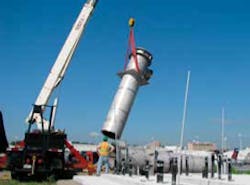After the Flood
Hurricane Sandy paralyzed LaGuardia Airport in New York as it rolled through the Northeast in October 2012. After the airport’s five storm water pump stations lost power, an estimated 100 million gallons of water built up to four feet deep at some points, including along the shuttle ramps of this busy hub.
Scope
High water on an airfield always presents a problem, but in the aftermath of the storm, the Port Authority of New York & New Jersey stepped up the planned replacement of the hydraulic and electrical muscle of its Pump Stations #4 and #6, which drain LaGuardia’s two runways.
The authority sought to replace the extended shaft propeller pumps at Stations #4 and #6 with submersible pumps, which would eliminate any concerns regarding conventional motor units being damaged by floodwaters. Submersible pump units have no aboveground motors that can be damaged and taken out of service due to impact.
Solution
To replace the existing pumping units, G. A. Fleet Associates, a full-service Flygt factory representative located in Harrison, N.Y., recommended Flygt PL-7101/300-hp electric submersible propeller pumps, which are designed to operate on the existing 4,160-VDC power supply. Each of these units are mounted in 48-in.-diameter steel tubes, have a capacity of 33,000 gpm and feature explosion-proof construction, which is approved for use in hazardous locations due to the possibility of petroleum products entering the wet wells. The first two pumps were installed at Pump Station #6, and another seven pumps, including one spare, await installation in Pump Station #4, following the completion of a new 5-kV substation.
Result
The replacement pumps function as an engineered system that improves the airport’s storm water control, flexibility and operational efficiency.
The profile of the replacement pumps also adds clearance because they install completely within the collection pit, unlike the taller vertical pumps, which protruded approximately 10 ft above grade level. Adopting a standard primary pump for the two runway storm water stations also enables an exchange with the spare pump in the event that a unit is removed for service.
The first two pumps are equipped with modular alarm system panels that detect and identify the specific nature of any malfunction. The alarm is transmitted via a fiber-optic communication line to a central station.
In addition to the turnkey engineering developed in collaboration with a Flygt applications engineer, G. A. Fleet Associates supplied the interface for the pump intakes, controls and other components to facilitate the replacement by the installation contractor. Flygt is a brand of Xylem Water Solutions USA Inc., which also supplied a number of smaller pumps for the airport’s upgrade program.
